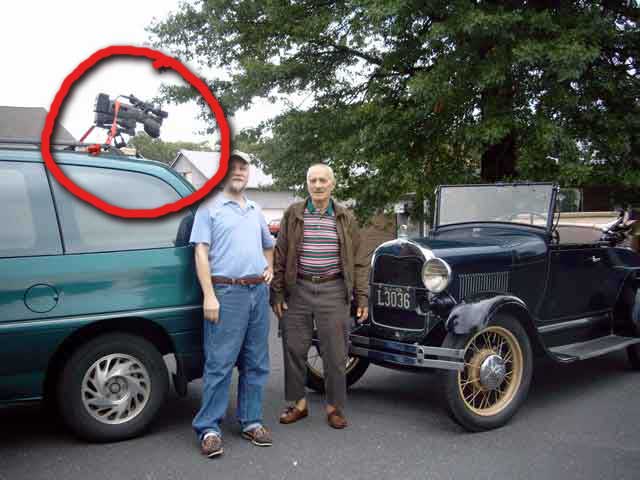
| Shooting from the roof of a moving vehicle. | ||
 |
||
| Our Sony DSR-200 DVCam video
camera allows us to get very smooth shots, even from a moving car. We have
several cameras, and the DSR-200 was the obvious choice for this application as
it utilizes optical image stabilization built into the lens. Most professional
cameras do not have any sort of built-in image stabilization. Shooting from a
shaky or vibrating platform, such as a vehicle in motion, results in shaky,
vibrating video! Optical image stabilization, unlike electronic image stabilization (such as is available on many consumer camcorders and even used professionally during the postproduction process via programs such as Final Cut Pro or AfterEffects) does not degrade the quality of the image. Optical image stabilization preserves the full resolution of the imaging chips, utilizing a servo-controlled prism to automatically compensate for any unsteadiness in the image being recorded. Electronic image stabilization, in contrast, "blows up" the image, allowing a variable subset of the full image to be output, which compensates for shakiness, but at the expense of reduced image sharpness. Other image stabilization methods we have used successfully include the Steadicam® and gyroscopically-stabilized lenses. We used a custom-made camera mount which adheres to smooth horizontal or vertical surfaces such as windows, fenders, hood and roofs of vehicles. This mount uses vacuum cups, as opposed to the more common suction cups, to achieve a grip of considerably more integrity (important when several thousand dollars worth of camera is hanging from them!). In addition, a safety strap tethers the camera to the vehicle. (Fortunately, we've never had to find out whether or not the safety strap would actually do it's job!). The mount contains a pan/tilt adjustment to compensate for any levelness issues of the surface on which the camera is mounted, and also to allow the camera to be aimed. Remote control of basic camera control functions such as iris and zoom settings allow us to tweak the look of the shot as we ride. We are currently experimenting with remote control pan/tilt mechanisms to allow changing the aim of the camera in mid shot. |
||